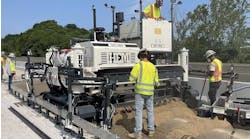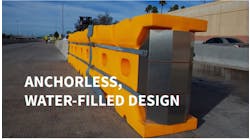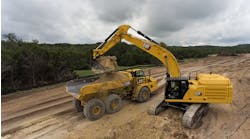At this point, most in the market do not mind having a drop in sandbags serve as rocket thrusters.
The growth in the construction industry over the past few quarters has felt more like a ride in a hot-air balloon—a steady climb upward. An aviation upgrade could be looming, but there are still indicators keeping the pilot seat in a basket instead of a cockpit, most notably the lack of a new long-term highway bill and the anchoring effect of regulations. Still, all indicators are pointing to increased elevation over the coming months.
“I have been to so many manufacturers the last two months, and I have not been to a single one that is not feeling pretty good about where they are,” Dennis Slater, president of the Association of Equipment Manufacturers (AEM), told Roads & Bridges. “At the front end of a recovery you tend to have that. They are cautious, but they are really liking the position their company is in.”
The latest Roads & Bridges Mid-Year Report does show a construction equipment market that has stabilized for the time being. When asked how they expect 2012 to rate as a business year, 38.1% said good, while 34.2% said it was going to be just mediocre. Just over 12% indicated the year was actually going to be very good, with only 10.6% calling it poor. Last year, during the inaugural check of the halfway point, mediocre was the top response (37.7%) followed by good (35.3%). The results were similar when R&B readers were asked about the overall health of their firm, with almost 40% marking it in good condition with another 31.7% saying things were OK. Just over 14% are feeling very good, with just 11.5% reporting a weak state.
Lending help
Thomas Brown, president of Sierra Pacific West Inc., a mid-range highway and bridge contractor, is feeling more good than average following a profitable 2011. Like many road builders, Sierra Pacific West was hit hard by the recession, which forced the Vista, Calif., outfit to reduce its 300-plus work force to around 100, with the latest layoffs happening 11 months ago. The American Recovery & Reinvestment Act stitched up the bleeding, but the company still feels a little tender in spots.
“Nothing has really gotten us excited about hiring,” Brown told Roads & Bridges. “Nothing has gotten us excited about investing in equipment or purchasing because of the economy.”
Brown’s most recent machine acquisitions have been forced; the California Air Resource Board (CARB) has required contractors to invest in Tier 4 engine technology quicker than the rest of the country. Sierra Pacific West replaced its on-highway fleet with the purchase of four Peterbilt haul trucks, and also purchased a large Caterpillar dozer. However, the unsettled economy and regulatory landscape is preventing Brown diving in.
“There is still some skepticism out there,” he said. “Am I going to invest in a million-dollar piece of equipment only to find out two years from now it is not good enough?
“What you are going to see is a lot of the earthmoving contractors, highway contractors across the nation going to stand down for a while and let the manufacturers or the dealers have rental fleets, and we will continue to rent that way.”
Brown said his firm has rented more over the last two years, especially when it comes to smaller pieces of iron like rollers and small dozers. Slater also felt that the rental industry was going to experience a strong year in 2012, and in turn many of the dealers were going to replace their fleets due to the strong demand.
When R&B readers were asked about their purchasing plans before the end of 2012, the top answer was nothing (38.9%) followed by on-highway trucks (24.5%), light equipment (22.7%) and excavators (20.1%).
The second half of the year looks solid for Sierra Pacific West. Brown said there was a backlog to tend to and enough work to make them profitable for a second straight year. However, 2013 does not look as bright even though the funding situation in California has remained relatively stable.
“I am a little concerned about moving into ’13 because we do not have a backlog that carries us that far, and especially if you don’t get a reauthorization, the projects are going to be few and far between. From that standpoint, I do not feel real good about it.”
For a majority of those surveyed, the next six months will look more like a holding pattern. Almost 50% of R&B readers say it will be flat, with 35.3% indicating it will actually be stronger than the first half.
Growing out of recession
According to the latest survey by AEM, 2012 is off to a record-setting start, and even though Slater does not believe the pace will hold, there is reason for optimism.
“It has been a good first quarter, and the second quarter is looking good, too,” he said. “I think some of the concern out there is the recovery in the U.S. seems to be slowing down, which raises some questions on the confidence in the market.”
Slater points to two areas that have ignited the recent surge: an aging fleet and the strength of exports thanks to productive countries like China, South America, India and even Russia.
“[Last year] was our best export year in seven years, and 2012 is starting to shape up that way, too.”
Overall, demand for construction equipment continued to improve during the first quarter of 2012, with four out of every five respondents to AEM’s Quarterly Industry Conditions survey reporting higher demand than a year ago. The net rising index came in at a very strong +78, just five points off the record of +83 notched in the first quarter of 2004. Demand for equipment has been expanding for nine straight quarters. The exports side rebounded in the first quarter of 2012, following low numbers in the fourth quarter of 2011. Almost half of the AEM respondents reported higher exports than a year ago.
Profit margins also remain steady, and just over 64% said their employment has been rising compared with the same quarter in 2011.
However, the rest of 2012 is expected to be slower. The AEM survey calls for normal to sluggish growth down the final stretch. Just over 20% of respondents say it is going to be flat.
“I think it is still going to be a good year, a growth year,” said Slater. “I don’t think it is going to be the sustainable level we had in the first quarter. Public spending is going to be under a huge stress just because the government is trying to cut.”
According to Slater, shortages on the manufacturing side are coming in the form of skilled labor and intermediate inputs. The supply chain also is not as good as it can be, and the instability in Europe still looms as a possible negative.
“The labor is really a local issue,” said Slater. “They really need to find solutions in their own area, and everybody is ramping up again so you are facing an immediate shortage in that area.” R&B


